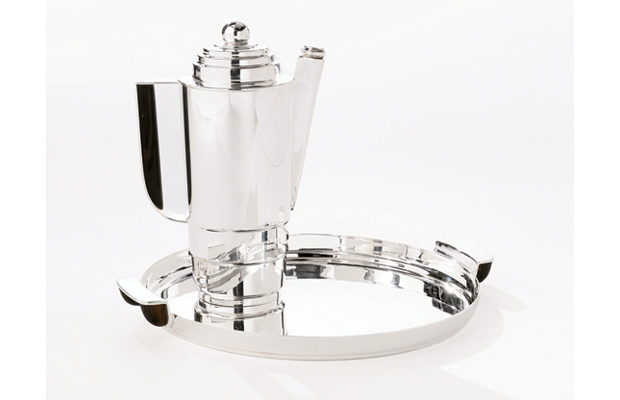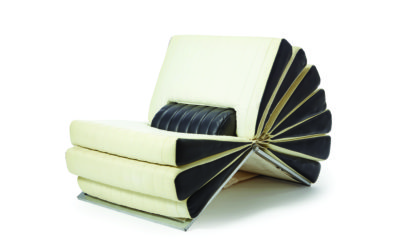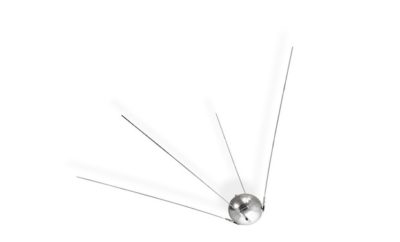
Design
What Sold, for How Much, & Why?

Silver Style cocktail shaker and tray designed by Kem Weber, c. 1928
Lot 154 Sotheby’s New York “20th Century Design“ sale, March 7, 2012: Silver Style cocktail shaker and tray designed by Kem Weber, c. 1928. Estimated at $7,000 to $9,000, the pair sold for $34,375. Some reasons for the unexpectedly high price:
Cocktail culture
Shakers are particularly collectible mementos of the Prohibition era, when speakeasies and home cocktail parties emerged as sites for the clandestine consumption of alcoholic beverages. Bootleg liquor was shaken with mixers that both improved the taste of low quality “bathtub gin” and also stretched precious reserves. Cocktail shakers have been around since the 1860s, but James Zemaitis, Sotheby’s director of twentieth-century design, who presided over the sale, considers the 1920s and 1930s the “great era of cocktail shaker design,” when nearly every well-known modern designer was issuing a shaker for a piece of the barware market. Zemaitis observes, “Among collectors there is such an appeal in collecting things from this era, not just for the romance of the Jazz Age, but also because it was a great moment in American design.”
Rare form
Born in Germany in 1889, and active in California from 1915 until his death in 1963, Weber is best known for his streamlined designs for furniture and consumer products, particularly his Airline chair (1934) and clock designs for Lawson Time Company (c. 1935). However, his rare works in silver occasionally surface at auction to the delight of modern-design collectors and cocktail shaker connoisseurs alike. Spurred by consumer demand for goods in the modern style coming from Europe, Brooklyn’s Friedman Silver Company contracted Weber in 1928 to design contemporary hollowware suitable for mass manufacture. The resulting Silver Style line (along with the To-day series, also for Friedman) embodies the quintessence of Weber’s graceful machine aesthetic. The shaker’s smooth cylindrical form is devoid of surface ornamentation; its telescoping base anticipates the horizontal streamlining and industrialized abstraction employed by Norman Bel Geddes, Raymond Loewy, and Gilbert Rohde during the 1930s. The ziggurat gradation of the cap echoes the look of a New York skyscraper. Weber designed just two shakers for Friedman and one for another forward-looking manufacturer, Porter Blanchard. Unrealized designs for other shakers and silver goods are housed with Weber’s archive at the University of California Santa Barbara.
Precious metal
Silver by Weber does reliably well on the auction block, and rare lots such as this one frequently exceed expected hammer prices. The stamped mark on the bottom of both pieces enhances the objects’ value in both primary and secondary markets. Weber’s silver pieces are in the collections of the Metropolitan Museum of Art and the Dallas Museum of Art, and Zemaitis has observed a “tremendous upsurge in interest on the part of American museums to collect design objects by the American émigré designers of the 1920s and ‘30s.” A forthcoming monograph on Weber’s historically understudied role in American design also “helps generate a high level of enthusiasm for this material,” Zemaitis says.
Shaking up the status quo
Weber was an important figure in the development and commercialization of the art moderne and streamline movements in America. Seeing the 1925 Exposition Internationale des Arts Décoratifs et Industriels Modernes in Paris deeply affected Weber’s design sensibility and cemented his belief in modernism to inspire a unique American design vocabulary for the twentieth century. One of the earliest proponents of art moderne on the West Coast, he singlehandedly introduced the style to California tastemakers with his designs for the Los Angeles furnishings store Barker Brothers and through his own design studio in Hollywood. In 1928, the same year he designed the Silver Style shaker, Weber cofounded the American Union of Decorative Artists and Craftsmen, which promoted modern American design through exhibitions and publications. Also in 1928 he participated in the InternationalExposition of Art in Industry organized by Macy’s, alongside acclaimed modernists Josef Hoffmann, Ilonka Karasz, and Weber’s former instructor Bruno Paul. Weber once remarked that his approach to designing a product mandated “keeping it simple and swift in line, not overly complicated, and yet giving it a certain rich elegance…that is typically American.”












